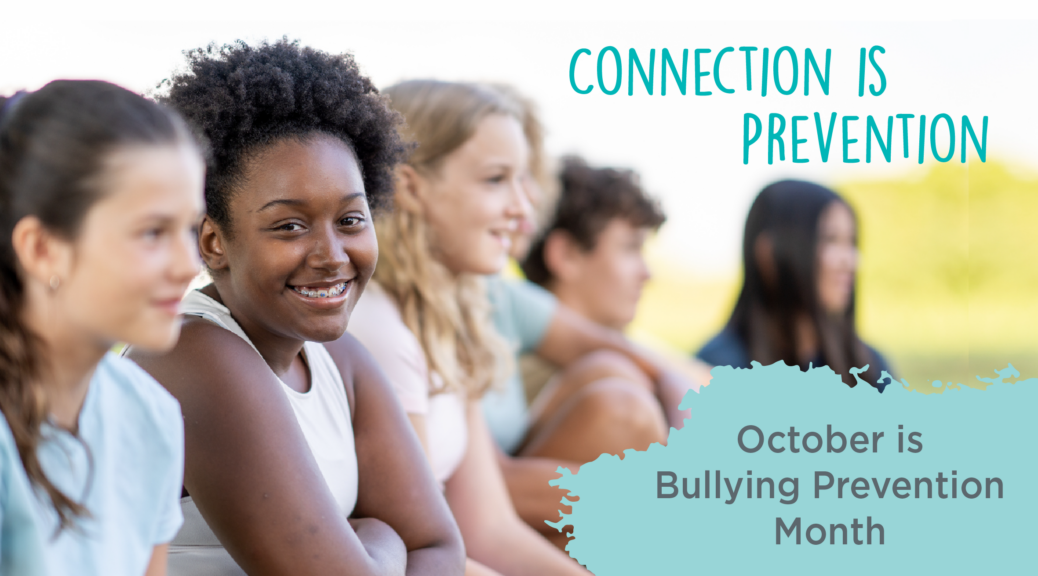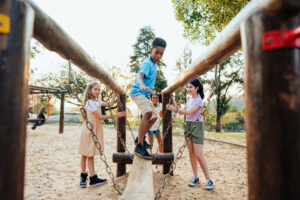Bullying Prevention: How Connection, Empathy and Action Can Make an Impact

It’s a startling trend: Bullying is on the rise. How can parents, caregivers, teachers and community members engage in bullying prevention?
More children than ever are being bullied, with bullying rates increasing 35% in recent years. Youth are showing an increase in knowledge and self-assuredness. However, they are also more competitive, sad and stressed than ever before. And children, teens and young adults are struggling with empathy, kindness and genuine loneliness, which is leading to a heightened amount of bullying and mental health struggles.
As Bullying Prevention Month, October is an ideal time to focus our collective efforts on reducing bullying for our young people. You know that old saying, “Sticks and stones may break my bones, but words can never hurt me?” Well, that’s not so true. It might sound like a nice idea to teach this to children as a buffer against the world’s unkindness. But it doesn’t prevent those words from causing emotional, mental and psychological harm.
Here at KVC Health Systems, we know empathy and connection have the power to positively impact childhood interactions, reducing the severity of bullying. With the goal of kindness and inclusion, we must first understand what makes a bully tick and the effects bullying has on the targets. Only then will we know how connection and empathy can help overcome bullying.
How to Spot Bullying
The first step in stopping bullying? Spotting it. Caregivers, educators and other influential adults can help young people by knowing what bullying looks like.
What is bullying? Bullying is the act of purposely and aggressively attacking someone. This can be physical or verbal with the intention to cause harm, humiliation, fear or distress. It not only causes trauma to the person being bullied but can also cause witnesses to feel distress, guilt, anger or other symptoms too. Ultimately, bullying has a negative ripple effect beyond the bully and the person on the receiving end. Bullying contributes to a culture of fear for other students too.
Bullying comes in many forms, and it’s important to be aware of how each presents themselves. Where physical and verbal bullying is often out in the open, other types of bullying like psychological or cyber bullying may be harder to spot.
Here are some common types of bullying:
- Physical Bullying: This involves any form of physical harm or aggression. This can include hitting, kicking, pushing or even damaging someone’s belongings.
- Verbal Bullying: Verbal bullying includes using hurtful words, insults, teasing or name-calling to belittle or humiliate someone. It can happen face-to-face or through online communication, where it can then be considered cyberbullying.
- Social Bullying: Also known as relational bullying, this type focuses on damaging someone’s reputation or relationships. It involves spreading rumors, exclusion, gossiping or manipulating social situations to isolate someone.
- Cyberbullying: This can occur through digital devices, like smartphones or computers. It involves using social media, online platforms, text messages or emails to harass, threaten or embarrass someone.
- Psychological Bullying: When someone tries to manipulate someone’s emotions, self-esteem or mental wellbeing. Those who choose this kind of bullying often use intimidation, coercion, blackmail or criticism with their targets.
- Sexual Harassment: Bullying of this nature involves unwanted sexual comments, gestures or behaviors. In many cases, sexual harassment can include sharing explicit content without consent, sexual advancements or even assault.
With such a variety of potential bullying situations, it can be hard to get to the bottom of why bullying happens in the first place. On the surface, bullies might seem tough and intimidating. Still, beneath their bold exterior, their motives likely stem from internal hurt, fear of the unknown, residual trauma, insecurity or learned behaviors. Regardless of the reason, the effects of bullying are far-reaching and can cause serious harm.
The Effects of Bullying
In a recent study, one in five students (ages 12-18) report being bullied at least once, but for some, bullying can seem like a daily occurrence. Especially with the rise in technology, cyberbullying is becoming increasingly common. Research reports that of the 25-35% or so of in-person bullying accounts, 15% are also experiencing cyberbullying. When combining the negative impact of in-person bullying and cyberbullying tactics, it’s no surprise that studies have linked the fact that youth are more than twice as likely to harm themselves from these experiences.
On top of the emotional and psychological wounds inflicted by humiliation, isolation and low self-esteem, targets of bullying can also struggle academically, physically and socially. These effects can seriously impact an adolescent’s ability to develop meaningful connections. Especially during a time with significant brain development, bullying could have long-term consequences.
 Overcoming Bullying: The Power of Connection and Empathy
Overcoming Bullying: The Power of Connection and Empathy
Overcoming bullying requires that all of us take action collectively. By embracing empathy and developing connections rooted in kindness, we have a chance to create positive change that can impact bullies, targets/victims and witnesses alike. Let’s explore how empathy and connection work to combat bullying.
Empathy
Empathy is a critical social skill that is the foundation for healthy communication and the ability to maintain safe, caring and meaningful connections and relationships. Many might assume that all bullies lack empathy, but that’s not necessarily the case. Research has found that bullies often possess cognitive empathy (which is knowing how a person might be feeling or thinking in a given situation), but they lack emotional empathy (which is understanding what a person is feeling and then responding to their pain appropriately).
However, early intervention and education could make the difference between a friend and a foe. With the majority of bullying cases happening out of adult sight, peer intervention becomes increasingly helpful in the prevention of attacks. By teaching and encouraging empathy, adolescents can practice kindness and acceptance no matter what differences others may have.
How can caregivers cultivate empathy for children? Here are some strategies:
- Start by modeling empathy yourself, with an inclusive attitude and posture within the home.
- Pay attention to the small stuff, keeping an eye out for opportunities to coach toward empathy
- Keep an open dialogue about empathy with children in your care, complimenting them when they display it towards others and affirming these thoughtful actions and attitudes
Connection
It’s no secret that America is in the midst of a loneliness public health crisis. In his advisory, Surgeon General Dr. Vivek Murphy notes that “our relationships are a source of healing and well-being hiding in plain sight — one that can help us live healthier, more fulfilled and more productive lives.”
When a positive sense of community and connection is fostered, it’s a powerful antidote against bullying. Studies show that teaching students to speak up when they witness bullying behavior and to take a stand against it, can reduce future bullying situations by more than 50%. Confidence is gained when a peer intervenes in a situation like bullying, and their ability to stand up for their beliefs encourages others to do the same and a positive and inspirational cycle is born. 
Plus, research indicates that when targeted students feel more connected to their peers, they are better able to cope with the effects of bullying. It all comes back to connection.
Caregivers and other adults can help children strengthen connections — and prevent bullying along the way:
- Encourage children and teens to reach out to a trustworthy adult connection at school when they notice even subtle signs of bullying. Adults like teachers, coaches, counselors and others can give comfort, support and advice, and can intervene if bullying escalates.
- Empower children to become an ally to students who are being bullied by showing kindness and getting help.
- Help young people establish strong connections through multiple avenues at school, like through activities, sports or hobbies, which builds community and confidence, as well as inclusive connections.
Since the trauma of bullying can affect our physical, mental, emotional and psychological senses, professional treatment or other resources may be needed throughout the healing process. With years of experience, KVC has helped so many children successfully overcome some of life’s greatest obstacles. We believe that we all need connection and through connection, true healing can happen.
 |




